|
Aurora Gallery back to spaceweather.com |
| Summary: Two coronal mass ejections hit Earth's magnetic field on Nov. 9th, causing a severe geomagnetic storm. Auroras were spotted in the United States as far south as California and Arizona. [See also the October 2004 aurora gallery.] Page 1 | Page 2 | Page 3 | Page 4 | Page 5 | Page 6 | Page 7 | This is Page 8 | Page 9 | Page 10 Got
pictures? Submit
them. |
| Photographer, Location | Images | Comments | |
|

|
Larry Koehn,
Nashville, Tennessee, USA Nov. 10 |
#1, more |
15 miles east of Nashville under a partly cloudy sky, I was able to see, for several minutes around 1:10am Wednesday morning, a fairly decent display. This was a 20 second expore on Kodak film. The camera is a Nikon50 camera with a 35mm lens. The sky was 60% filled with cirrus and cirrus-stratus clouds. Otherwise, I have no idea why I went out because of the clouds, but the effort paid off. |
|
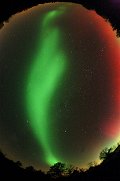
|
Vic & Jen Winter,
Warrensburg, Missouri, USA - November 7, 2004 Nov. 07 |
#1, #2, #3, more |
This was perhaps the best aurora display in the Missouri area since the wonderful display almost 13 years to the day back in November 8, 1991. |
|
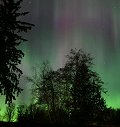
|
Wade B Clark Jr,
Near Lyman, Washington State, USA Nov. 07 |
#1, #2, #3, more |
Photo details: Canon Digital Rebel, 18 to 55mm f3.5 lens, ISO setting of 1600, and exposure times of about 40 seconds. |
|
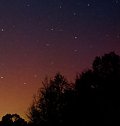
|
Robert T. Smith,
Stoneville, NC, USA Nov. 10 |
#1, #2, #3, more |
On Nov 9/10, space weather indicators were showing lots of red on the sites that I check, but outside things were not nearly as visible on Nov 7/8. But I knew something must be happening so I kept pointing North and shooting film, despite freezing temperatures and lack of sleep. Kodak 400 film.Exposures varied from seconds to minutes. Persistence finally gets results as the colors change from frame to frame. Thanks for all the info--please explain the variations in color. |
|

|
Brian Larmay,
Youngstown, New York, Old Fort Niagara beach area. Nov. 09 |
#1, #2, more |
A faint but pleasing aurora that I captured using Fuji Super G 800, and a 28mm lens attached to a Nikon FG. |
|

|
Todd Lindley,
Midland, Texas, USA (31.4N) Nov. 07 |
#1, |
A brief glimpse of Sunday night's aurora through breaks in cirrus overcast. The auroral glow was not visible, but showed up in photos. |
|
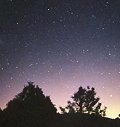
|
Brendan Sisson,
Duns Creek, NSW Australia Nov. 10 |
#1, more |
Not often we see Aurora's here, at a latitude of 32 degrees South! A very faint haze could be seen with the naked eye but the film picked up a nice red/purple glow over the lights of Maitland. Nikon FM10 400 ASA film, 30 seconds exposure |
|

|
Steven Yezek,
near Plymouth, Iowa, USA Nov. 10 |
#1, #2 |
These pics were taken on a Canon EOS Rebel with 800ASA and around 30sec exposer. These were taken about 1:30am, at first the sky was really cloudy and I wasn't sure if I would be able to see anything tonight, but by luck the skies cleared just a little to give an awesome show. |
|
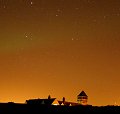
|
Pete Lawrence,
Freezing on Selsey Beach (next to Selsey Bill - the most southernmost tip of the peninsular where I live). Nov. 10 |
#1, #2, more |
Aurorae are not that common in Selsey. This one was particularly faint and almost lost in the light pollution over the town. Very cold on the beach but I was able to point out the light show to a couple of freezing fishermen. |
|
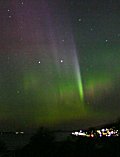
|
Danny Ratcliffe,
Hobart Tasmania, Australia taken at 1am local time 11/11/04 (14:00UT) Nov. 11 |
#1, |
The red banding was not visible till the pics were uploaded. taken with a Canon 300D ASA 800 approx 20 sec exp |
|

|
Scott C. Holgorsen,
Davenport, Iowa. USA Nov. 07 |
#1 |
It looked like a river of light. Samsung 800 asa film. Held shutter open for 10 seconds. |
|
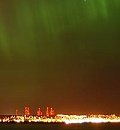
|
Chris Bode,
Superior, Wisconsin, looking toward Duluth, Minnesota. Nov. 07 |
#1, more |
This display was so bright that I could read my watch by them. Photo details: Nikon D100, Nikkor 18-35 lens, 30s exposure at F4 with in-camera noise reduction. |
| more images: from Bobbie M of Gilmanton Iron Works, NH; from Kenneth M of S. Seattle, Washington; from Alan C Tough of Elgin, Moray, Scotland; from Mark Poe of Sioux Falls, SD; |

